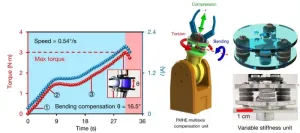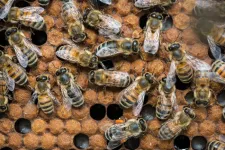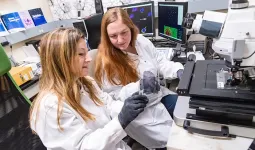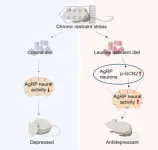Scientists develop self-tunable electro-mechano responsive elastomers
2023-03-03
(Press-News.org)
Recently, a team led by Prof. ZHANG Shiwu from the University of Science and Technology of China (USTC) and their collaborators from UK and Australia developed a new electro-mechano responsive elastomer that autonomously adjust stiffness, conductivity and strain sensitivity in response to changes in external mechanical loads and electrical signals. Their research was published in Science Advances.
Nowadays, more and more application scenarios like soft robotics and medical surgical equipment call for self-tunable intelligent materials. A widely adopted solution is composite material composed of low melting point alloy and elastic polymer. However, such material is unable to automatically respond to external changes and can only switch between conductive and insulating states.
To fill this gap, the team developed a Field’s metal-filled hybrid elastomer (FMHE) composed of nickel (Ni) microparticles, low melting point Field’s metal (FM) and polymer matrix. The multi-filler conductive network formed by spiked Ni particles and FM particles enables the conductivity of the FMHE to grow exponentially under different mechanical loads such as compression, twist and bend. When FMHE is heated to 60℃ and above, the FM particles within are melted. Melted FM droplets can’t form conductive paths like solid particles, but deforms with polymer matrix under load, which significantly reduces the elastic modulus, conductivity and strain sensitivity. Since the material’s electrical resistance decrease as it deforms, self-tunable conductivity and stiffness can be achieved by heating and applying certain pressure on FMHE.
Combining the variable resistance and stiffness properties, the research team developed a self-triggered multiaxis compliance compensator for robotic manipulators, which can compensate for positional and angular errors through its deformation, avoiding damage to equipment in complex operating environments. The team’s FMHE-based device showed greater compensation capability than that of current commercial systems (bending angle of 16.5° over 1.1°). Furthermore, the team developed a resettable current-liming fuse based on FMHE. When reaching the fusing current, the resistance of the fuse can increase 1000 times in 0.1 seconds to cut off the circuit and reset in 10 seconds.
The intelligent materials developed by the team enabled synergistic utilization of tunable electrical and mechanical properties, showing great potential in its application to the next generation soft robotics and electronic devices.
END
ELSE PRESS RELEASES FROM THIS DATE:
2023-03-03
Greenhouse gases act like a layer of window glass in the atmosphere: They prevent heat from being radiated from the Earth's surface into space. Methane does that 28 times as effectively as carbon dioxide - it is (to stay in the picture) a kind of invisible double glazing.
Over the past 200 years, the concentration of methane in the atmosphere has more than doubled. This is mainly due to human meat consumption: For one thing, cows and other ruminants produce methane during digestion. Another important source is the excrement of the animals. "One-third ...
2023-03-03
Though wildlife trafficking has been effectively disrupted since the first World Wildlife Day—established 50 years ago today via the 1973 Convention on International Trade in Endangered Species (CITES) of Wild Fauna and Flora—a newly published case study on one of the world’s rarest tortoise species, the ploughshare tortoise, highlights how much room for improvement still exists.
In a new paper published in the Proceedings of the National Academies of the Sciences, University of Maryland Associate Professor Meredith Gore and her coauthors—Babson College’s Emily Griffin, ...
2023-03-03
An international team of bee researchers involving Heinrich Heine University Düsseldorf (HHU) has integrated a calcium sensor into honey bees to enable the study of neural information processing including response to odours. This also provides insights into how social behaviour is located in the brain, as the researchers now report in the scientific journal PLOS Biology.
Insects are important so-called model organisms for research. Despite more than 600 million years of independent evolution, insects share more than 60% of their DNA with humans. For several decades it was mainly the fruit fly ...
2023-03-03
Pain afflicts at least 1.5 billion people worldwide, and despite the availability of various painkilling drugs, not all forms of pain are treatable. Moreover, pain medications can have side-effects such as dependence and tolerance, especially in the case of morphine and other opioids.
In search of novel painkillers, researchers at Butantan Institute’s Special Pain and Signaling Laboratory (LEDS) in São Paulo, Brazil, studied TRPV1, a sensory neuron receptor that captures noxious stimuli, including heat and the burning sensation conveyed by chili peppers, and ...
2023-03-03
Certain chemotherapy-resistant ovarian cancer cells protect neighboring cancer cells by sending signals that induce resistance, according to a new study from University of Pittsburgh and UPMC researchers that may help explain why ovarian cancer patients respond poorly to chemotherapy or relapse after treatment.
Published in Clinical Cancer Research, the study investigated chemotherapy-resistant cancer cells called quiescent cells. As chemotherapy primarily targets rapidly dividing cells, quiescent cells are resistant because they divide ...
2023-03-03
Males of a species evolving traits for sexual conflict can cause problems for females, and, ultimately, the whole population.
A new model by Imperial College London and University of Lausanne researchers, published in Proceedings of the National Academy of Sciences, shows how so-called ‘good genes’ can sometimes cause a population to collapse.
Males of any species may compete for females, either by fighting other males for access or impressing females to win their approval. In both cases, ...
2023-03-03
A new study led by UC Davis MIND Institute researchers confirms that brain development in people with autism differs from those with typical neurodevelopment. According to the study published in PNAS, these differences are linked to genes involved in inflammation, immunity response and neural transmissions. They begin in childhood and evolve across the lifespan.
About one in 44 children in the U.S. has autism. Autistic individuals may behave, communicate and learn in ways that are different from neurotypical people. As they age, they often have challenges with social communication ...
2023-03-03
Although electron microscopy can already reveal details as small as one nanometer, ongoing research seeks to break through barriers limiting image quality and reducing the optical dose on the samples. Aberration is a common problem in electron microscopy that can reduce the resolution and quality of the images produced. Additional complex phase and amplitude controls are needed in these microscopes. An international team of researchers led by Akhil Kallepalli (Kallepalli Lab) working within the Optics Group at the University of Glasgow set out to address the problem. Working from an optics perspective, they developed and tested a new ghost ...
2023-03-03
Tree-ring analysis – so-called dendrochronological analysis – has been part of archaeology for many years and has made it possible for archaeologists to date old wooden objects with great precision. And in many cases, they have also been able to determine the provenance of the wood.
But it has proven difficult for researchers to determine timber’s place of origin when the historic timber was imported into Denmark from further afield to serve as building material.
In a new study in the journal PLOS ONE, Associate Professor Aoife Daly and Dr Alicia Van Ham-Meert from the University of Copenhagen show that combining analyses of ...
2023-03-03
Depression is a leading cause of disability around the world and contributes greatly to the global burden of disease. Nutrition is essential for the maintenance of normal emotional states. Nutritional therapy is rising up in many disease treatments, but little is known in the depression field. Unbalanced nutrition is implicated in the etiology of depression, potentially hindering treatment. For example, many essential amino acids (EAAs) in serum are changed in patients with depression, such as tryptophan, threonine, leucine, isoleucine, and valine. However, whether EAA contributes to depression ...
LAST 30 PRESS RELEASES:
[Press-News.org] Scientists develop self-tunable electro-mechano responsive elastomers










